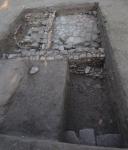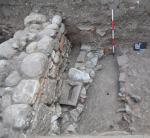Summary (English)
In 2019, the Austrian Mission continued the exploration of the eastern quarter of the city in zone QE 3000. The main aim of the campaign was to extend the excavations in the area where road QE 12/13 crossed road QE-SE3 (excavated 2016-2018), towards the south, to gain a better understanding of the relationship between the terracing wall FQE 3032 (phase 2) and the channel FQE 3022 (phase 3). The aim was also to define the dimensions of the building with the large courtyard (phase 4).
While the evidence for the first phase, of Hellenistic date, remained scarce, the excavation of road QE12/13 built in the 1st century A.D., revealed a well-made paving of flysch and sandstone to the south of the point where it met road QE-SE3. The 2019 excavations identified a new building, formed by wall FQE 3004 and a row of sandstone blocks (US 209/19) that ran parallel to wall FQE 3004 for three metres. Given the limited extension of the excavated area, it is difficult to identify the structure type, but it may have been a type of stoà.
The channel FQE 3022, identified in trench 1/19, can be attributed to phase 3, datable to within the first half of the 1st century A.D. The trench clearly showed that for the channel’s construction the continuation of the terracing wall FQE 3022, no longer functioning, was eliminated. As seen in trenches in previous years, the paved road surface in trench 1/19 was covered by mud from a large landslide, mixed with small pumice inclusions deriving from the eruption of Vesuvius in 79 A.D. highlighting the consequences of the event for most of Campania.
These landslides caused a general reorganisation of the east quarter. To the west of the old road QE12/13, a structure was built that has been reconstructed as a substantial complex with a large courtyard, surrounded on three sides by a portico, according to the results of the geophysical survey. On the northern edge of trench 1/19, wall FQE 3049 was identified, which constituted the southern perimeter of the complex’s east wing, thus further defining the building’s dimensions (57.80 × 42.60), although some problems remain regarding the interpretation of the geophysical results.Last year’s excavations showed that this large complex was abandoned in the late 2nd or early 3rd century A.D. A ritual context, dating to the early 3rd century A.D., was found in the zone of the old channel just south of the complex. It comprised the deposition of a small headless sheep in a pit, surrounded by tile fragments (FQE 3051). Next to it, there was the neck of an amphora, perhaps used for making libations. This feature was similar to a situation found just north, where the skeleton of a dog, also headless (FQE 3010) was positioned between several layers of tiles.
- Verena Gassner, Günther Schörner, Università di Vienna, Istituto di Archeologia Classica
Director
- Verena Gassner, Günther Schörner, Università di Vienna, Istituto di Archeologia Classica
Team
- Angelo d’Angiolillo-Ascea
- Regina Klingraber-Università di Vienna
Research Body
- Università di Vienna, Istituto di Archeologia Classica
Funding Body
- Facoltà delle discipline umanistiche dell’Università di Vienna






![Download [PDF]](/excavation/skins/fasti/images/results/download_sml.png)
